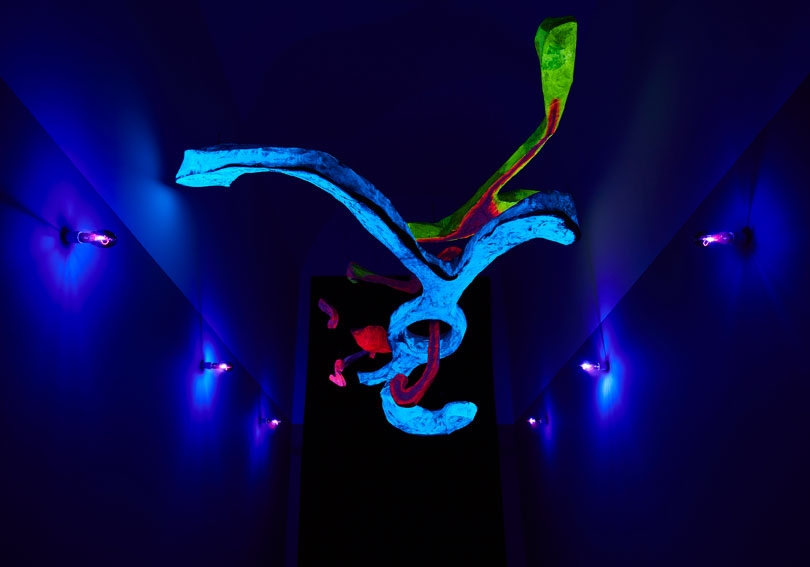Pirelli Hangar Bicocca, Milan, 21 September – 25 February
‘History always constitutes the relation between a present and its past,’ John Berger wrote in Ways of Seeing (1972). It was only after the advent of Neorealism, for instance, that Caravaggio was ‘rediscovered’ by Italian art historian Roberto Longhi, who revived the painter’s myth with a groundbreaking exhibition at Palazzo Reale in Milan. By coincidence, while a blockbuster reenactment (Dentro Caravaggio) of that show is taking place at the same venue, Hangar Bicocca has mounted a retrospective of Lucio Fontana that reframes our ways of looking at his revolutionary relationship to space, body, perception and new media – all familiar tropes of the current ‘information age’.
It was in postwar Milan, where Fontana moved back in 1947 (from Argentina, where he was born in 1899), that the artist theorised – in his Spatialist Manifesto – the need for ‘painting to emerge from its frame’ and for art to embrace science, radio and television. By ‘using the resources put at our disposal by modern technologies, we shall produce in the sky: artificial shapes, miraculous rainbows, luminous writings’, he wrote in 1948. His experiments on canvas brought him to the new series of Concetti Spaziali (Spatial Concepts), first with the ‘holes’ (1949), then with the famous ‘cuts’ (1958). But Fontana’s ambitions were more radical than this. In 1949, at the Milanese Galleria del Naviglio, he created a Spatial Environment in Black Light, open for six days only, where sculptural elements painted in fluorescent colours (violet, rose, blue) and hung from the ceiling were illuminated by UV lights, hence appearing as free-floating in the dark.
It’s not a matter of establishing who ‘invented’ what, but to relocate the birth of an artform on a broader scale
That first environment is also the starting point for this retrospective. Curated by Marina Pugliese and Barbara Ferriani, together with Vicente Todolí, the exhibition works as a rigorous exercise in art-historical philology and research, not only into the art but also into audience accessibility. The layout is elegantly simple: the nine environments – five of which, reexhibited for the first time since Fontana’s death – are reconstructed in 1:1 scale by using their original materials (neon, UV lights, metallic wallpaper, carpeting, rubber flooring) and enclosed in black boxes. The sequence is chronological, from 1948 to 68, and the venue is very dimly lit, as if at night, preserving the perceptual and optical effects of the visitor’s encounter with black light, immersive colours, obscurity pierced by fluorescent dots and unbalancing surfaces devised by Fontana (who regularly worked in collaboration with architects, and who cosigned Ambiente Spaziale ‘Utopie’ (Spatial Environment ‘Utopias’, 1964) with artist Nanda Vigo). There are only two brightly luminous reconstructed installations, positioned at the beginning and end of the show’s parcours. Above the entrance hangs the spectacular Struttura al neon per la IX Triennale di Milano (Neon Structure for the 9th Milan Triennale, 1951), an impressive neon ‘scribble’ suspended from an oval ceiling, painted in ‘Giotto blue’ – another version of which is permanently on show at Milan’s Museo del Novecento. Fonti di energia, soffitto al neon per ‘Italia 61’, a Torino (Energy Sources, Neon Ceiling for ‘Italia 61’, in Turin, 1961) occupies the cubic space at the end of the Hangar with hundreds of green and blue neon tubes, arranged on different levels and following divergent diagonal lines, hence generating a blinding full-immersion into a geometrical and abstract space.
This exhibition seems finely attuned to another latter-day trend of the art-historical sphere, ie the disruption of the evolutionistic patterns of ‘modernity’ and modernism at large, in favour of a more pluralistic, polycentric and less US-obsessed narration. Reconstructing Fontana’s forgotten research in the fields of environments, light and space implies also expanding the chronologies of art, and redefining its lineages. Some of his works predate those of Dan Flavin, Allan Kaprow and Bruce Nauman. It’s not a matter of establishing who ‘invented’ what, but to relocate the birth of an artform on a broader scale: to move it not from margin to centre, as Julie H. Reiss’s famous book about installation art once had it, but from centre to margin.
From the December 2017 issue of ArtReview
